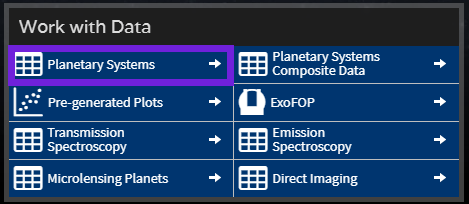About the Planetary Systems Table
Since the archive was created in 2011, the field of exoplanet science has evolved in relatively a short time. The astronomical community's understanding of planetary systems has also evolved, so it was time to update the archive to reflect this new world. To that end, the NASA Exoplanet Archive rolled out thePlanetary Systems (PS) interactive table that combines the data from two tables that were previously supported by the archive: Confirmed Planets and Extended Planet Data tables.
The PS table gives users an interactive way to browse ALL solutions for planet and host star solutions, regardless of their relationship. This approach enables the archive to present data for atypical systems, including free-floating planets and those with multiple stars. Other PS table features include:
- Each row contains planet, stellar and system (TESS Input Catalog) properties.
- All solutions for confirmed exoplanet systems are provided in a single table, including Kepler, K2, and TESS candidate solutions.
- The table provides a nearly complete identification of published stellar companions in confirmed planetary systems.
- Measurements of projected and true planet obliquities are included.
- The table contains a summary of data sets available in the archive for a given system.
Access the Planetary Systems interactive table from the Data drop-down menu or our homepage's Work With Data area:

Query-based Table Access
The PS Table can also return data programmatically through the archive's Table Access Protocol (TAP) Service. To build a query, review the TAP User Guide and the Data Column Definitions.
See also:
- Developing a More Integrated NASA Exoplanet Archive: How the archive's data tables and services are changing, and when.
- Archive 2.0 Release Notes
- Planetary Systems interactive table
- Planetary Systems Composite Parameters interactive table
- Interactive Table User Guide: How to access, sort, filter, plot and download table data.
- Planetary Systems Composite Parameters Table Calculations: How the archive calculates values in the Planetary Systems Composite Parameters table.
- Exoplanet Criteria: The archive's policy on including and excluding planets.
- Data Column Definitions: A detailed list and description of each parameter in both Planetary Systems tables.
- Table Access Protocol (TAP) User Guide: Build a a query to automate data downloads from the archive.
Last updated: 19 April 2021




